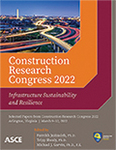Measurement and Verification and Model Validation to Evaluate Energy and Demand Savings from Smart Building Technologies in a Residential, Controlled Laboratory
Publication: Construction Research Congress 2022
ABSTRACT
Energy consumption and electricity demand in the residential building sector depends significantly on the energy consuming devices in a building, the building envelope, and the occupants’ interaction with these systems. To evaluate the reliability, energy saving potential, and demand reduction potential of various occupancy sensor systems connected to the heating, cooling, and ventilation (HVAC) systems in residential buildings, a full-scale experimental test setup was developed, including two parallel, identical test buildings built to current energy codes and built to be consistent with residential building construction techniques and typical residential systems. To evaluate energy and demand savings, first, normalization testing was completed to ensure that both buildings were operating similarly. The energy use collected over several weeks was compared, then adjustments were made to each building, then the buildings were re-tested in an iterative process to ensure similar operation and consumption patterns. Following normalization, baseline data was then collected to calibrate an energy model of the test buildings. An energy model was developed using EnergyPlus to mimic the laboratory conditions and calibrated and validated to fit the measured data following ASHRAE Guideline 14. This paper discusses the development, construction, and instrumentation of the laboratory facilities for experimental smart technology testing, and the development, calibration, and validation of the building energy model. Future applications of these parallel laboratories include their use to evaluate performance impacts from various smart building technologies. This effort can be useful for those developing experimental full-scale laboratory test facilities and those engaging in occupancy sensor system evaluation.
Get full access to this article
View all available purchase options and get full access to this chapter.
REFERENCES
DOE. Building America Analysis Spreadsheets. https://www.energy.gov/eere/buildings/building-america-analysis-spreadsheets, accessed on June 10th, 2021.
Cao, X., X. Dai, and J. Liu. “Building Energy-consumption Status Worldwide and the State-of-the-art Technologies for Zero-energy Buildings during the past Decade.” Energy & Buildings 128 (2016): 198–213.
Christensen, C., R. Anderson, S. Horowitz, A. Courtney, and J. Spencer. BEopt (TM) software for building energy optimization: Features and capabilities. National Renewable Energy Lab.(NREL), Golden, CO (United States), 2006.
Crawley, D. B., L. K. Lawrie, C. O. Pedersen, and F. C. Winkelmann. “Energy plus: energy simulation program.” ASHRAE journal 42, no. 4 (2000): 49–56.
EIA (Energy Information Administration). Residential Energy Consumption Survey (RECS) Table HC1.1 Fuels used and end uses in U.S. homes by housing unit type, 2015. https://www.eia.gov/consumption/residential/data/2015/hc/php/hc7.1.php, accessed on June 10th, 2021.
ELEMENTS, https://bigladdersoftware.com/projects/elements/, released on Nov 29, 2016.
EPPY, https://pypi.org/project/eppy/, released on Nov 5, 2020.
Guideline, A. S. H. R. A. E. Measurement of energy, demand and water savings. (2014).
Hadley, D. L. “Daily variations in HVAC system electrical energy consumption in response to different weather conditions.” Energy and buildings 19, no. 3 (1993): 235–247.
Jain, R. K., J. E. Taylor, and P. J. Culligan. “Investigating the impact eco-feedback information representation has on building occupant energy consumption behavior and savings.” Energy and Buildings 64 (2013): 408–414.
Menyhart, K., and M. Krarti. “Potential energy savings from deployment of Dynamic Insulation Materials for US residential buildings.” Building and Environment 114 (2017): 203–218.
Qin, H., and W. Pan. “Energy use of subtropical high-rise public residential buildings and impacts of energy saving measures.” Journal of Cleaner Production 254 (2020): 120041.
DOE. Residential Prototype Building Models. https://www.energycodes.gov/development/residential/iecc_models, accessed on June 10th, 2021.
Wang, C., K. Pattawi, and H. Lee. “Energy saving impact of occupancy-driven thermostat for residential buildings.” Energy and Buildings 211 (2020): 109791.
Information & Authors
Information
Published In
History
Published online: Mar 7, 2022
Authors
Metrics & Citations
Metrics
Citations
Download citation
If you have the appropriate software installed, you can download article citation data to the citation manager of your choice. Simply select your manager software from the list below and click Download.
